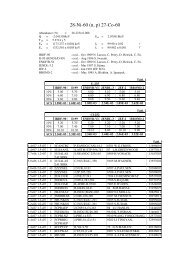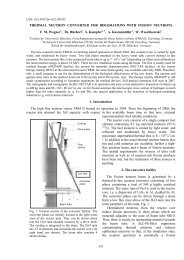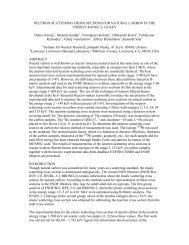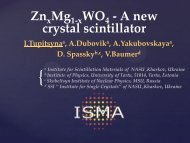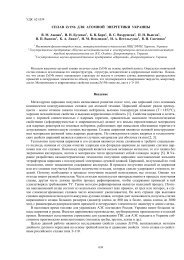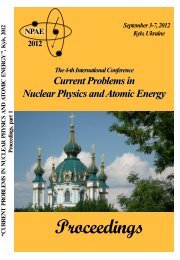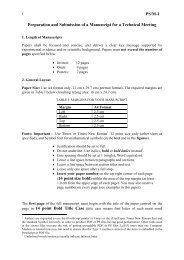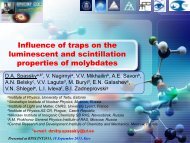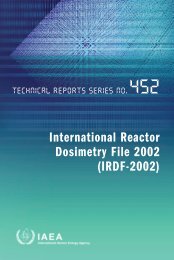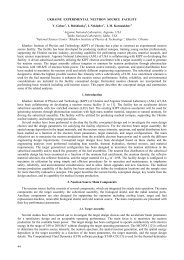Dinh Dang.pdf
Dinh Dang.pdf
Dinh Dang.pdf
You also want an ePaper? Increase the reach of your titles
YUMPU automatically turns print PDFs into web optimized ePapers that Google loves.
where E γ<br />
≡ ω is used to denote the energy of γ -emission. The normalization factor c<br />
1<br />
is defined so that the<br />
total integrated photoabsorption cross section σ = ∫ σ( E ) dE satisfies the GDR sum rule SR GDR , hence<br />
γ<br />
γ<br />
Emax<br />
1 SR GDR<br />
GDR<br />
0<br />
c = ∫ S ( Eγ ) EγdEγ<br />
.<br />
(11)<br />
In heavy nuclei with A ≥ 40, the GDR exhausts the Thomas-Reich-Kuhn sum rule (TRK)<br />
SR GDR = TRK ≡ 60 NZ/ A (MeV⋅ mb) at the upper integration limit E max<br />
30 MeV, and exceeds TRK<br />
( SR GDR > TRK ) at E<br />
max<br />
> 30 MeV due to the contribution of exchange forces. In some light nuclei, such as<br />
16 O, the observed photoabsorption cross section exhausts only around 60 % of TRK up to Emax<br />
30 MeV.<br />
B. Thermal pairing<br />
The standard finite-temperature BCS (FT-BCS) theory ignores fluctuations of the quasiparticle number.<br />
As a result, the BCS breaks down at a critical temperature T c<br />
0567 . ∆ ( T = 0) , which corresponds to the<br />
sharp transition from the superfluid phase to the normal-fluid one. It has been known that, in finite systems<br />
such as nuclei, thermal fluctuations smooth out this phase transition [6].<br />
The modified BCS (MBCS) theory [7] proposes a microscopic way to include quasiparticle-number<br />
fluctuations via the secondary Bogolyubov’s transformation<br />
α<br />
= − n α + n α , = n α − n α . (12)<br />
†<br />
jm 1<br />
† †<br />
j jm j jm jm<br />
α<br />
j jm<br />
j jm<br />
Using Eqs. (12) in combination with the original Bogolyubov’s transformation, one obtains the<br />
transformation from the particle operators directly to the modified quasiparticle operators in the following<br />
form<br />
where the coefficients<br />
u j and<br />
a<br />
= + , a = − , (13)<br />
† † †<br />
jm u jα jm v jα jm j jm<br />
jm<br />
u α v jα<br />
jm<br />
v j are related to the conventional Bogolyubov’s coefficients<br />
u<br />
j<br />
u<br />
j<br />
and v<br />
j<br />
as<br />
= u 1− n + v n , v j = v 1−n − u n . (14)<br />
j j j j j j j j<br />
†<br />
The transformation of the pairing Hamiltonian (1) into the modified quasiparticles α jm and α jm has the<br />
form identical to that obtained within the conventional quasiparticle representation with ( u j , v j ) replacing<br />
† †<br />
( u<br />
j<br />
, v<br />
j<br />
) and ( α jm , α jm ) replacing ( α<br />
jm<br />
, α<br />
jm<br />
), respectively. The MBCS equations, therefore, has exactly<br />
the same form as that of the standard BCS equations, where the coefficients u<br />
j<br />
and v<br />
j<br />
are replaced with u j<br />
and v j , i.e.<br />
∑ ∑ (15)<br />
∆= G Ω = G Ω − n u v − n −n u − v ,<br />
j<br />
2 2<br />
juv<br />
j j<br />
j[(1 2<br />
j) j j j(1 j)( j j)]<br />
j<br />
∑ ∑ (16)<br />
N = Ω = Ω − n v + n − n − n u v ,<br />
2<br />
2<br />
2<br />
jv<br />
j 2<br />
j[(1 2<br />
j) j j<br />
2<br />
j(1 j) j j]<br />
j<br />
j<br />
The last terms at the rhs of these MBCS equations contain the quasiparticle-number fluctuations nj<br />
(1 − nj<br />
)<br />
on j − th orbitals, which are not included in the standard FT-BCS theory.<br />
C. EM cross sections of GDR and DGDR<br />
The EM cross section σ<br />
EM<br />
is calculated from the corresponding photoabsorption cross section σ ( E γ<br />
)<br />
and the photon spectral function N ( E γ<br />
) as<br />
∫ ∫ (17)<br />
σ N E σ E dE N E π ∞ −<br />
= , = N E , b bdb.<br />
mb ( )<br />
EM<br />
(<br />
γ) (<br />
γ) γ<br />
(<br />
γ) 2 e (<br />
γ<br />
)<br />
bmin<br />
73



